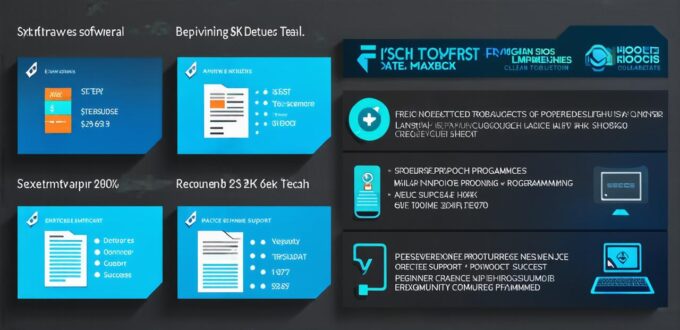Introduction:
Programming software is a skill that’s in high demand, and it’s no wonder. With the world becoming more digitized by the day, there is a constant need for individuals who can create and maintain software programs that run smoothly and efficiently. However, if you’re new to programming, it can be overwhelming to know where to start. In this guide, we will walk you through the steps needed to begin programming software, from choosing your first language to finding resources to help you along the way.
Choosing Your First Language:
The first step in learning how to program software is to choose a language. There are numerous programming languages out there, each with its own strengths and weaknesses. Some of the most popular languages include Python, Java, C++, JavaScript, Ruby, PHP, and SQL. The choice of language will depend on your personal preferences and the type of software you want to create.
Python is a great language for beginners because it’s easy to learn and read. It also has a vast library of modules that can help you get started quickly. Java is another popular language for beginners, as it’s object-oriented and has a strong focus on structure and organization. C++ is more challenging but offers better performance and control over the code.
JavaScript is essential for web development and allows you to create dynamic and interactive websites. Ruby is ideal for building web applications, while PHP is used extensively for creating and managing content management systems (CMS) like WordPress. Finally, SQL is a great language for working with databases and managing data.
Once you’ve chosen your language, it’s time to start coding!
Setting Up Your Development Environment:
The next step is to set up your development environment, which includes the software and tools you’ll use to write and test your code. This will depend on the language you’re using, but there are some common tools that all programmers should have in their toolkit.
For Python, you’ll need a text editor (like Visual Studio Code or Atom) and an interpreter (like IDLE or Jupyter Notebook). For Java, you’ll need a code editor like Eclipse or IntelliJ IDEA and the Java Development Kit (JDK). For C++, you’ll need a code editor like Visual Studio Code or Dev-C++ and the C++ compiler.

For JavaScript, you’ll need a text editor and a web browser to test your code. For Ruby, you’ll need a text editor and the Ruby programming language interpreter. Finally, for SQL, you’ll need a database management system like MySQL or PostgreSQL and a text editor.
Learning the Basics of Programming:
Now that you have your development environment set up, it’s time to start learning the basics of programming. This includes learning the syntax of your chosen language, understanding data types, control structures (like loops and if/else statements), functions, and arrays.
One way to learn is by taking an online course or tutorial. There are numerous free and paid courses available on platforms like Coursera, Udemy, and Codecademy that can help you get started. Additionally, there are countless resources available online, including blogs, forums, and documentation that can provide guidance and support as you learn.
Practice Makes Perfect:
The best way to become proficient in programming is through practice. The more you write code, the better you’ll get. One way to practice is by working on small projects or exercises. These can be found online or created yourself.
Another great way to practice is by contributing to open-source projects. Open-source software is free and available for anyone to use, modify, and contribute to. This is a great way to learn from other programmers and get your name out there in the development community.
Real-World Examples:
One of the best ways to illustrate how programming works is through real-world examples. For example, let’s say you want to create a simple weather application that shows the current temperature and weather conditions for a given location. To do this, you would need to use an API like OpenWeatherMap to retrieve weather data for the chosen location. You would then use this data to display the current temperature and weather conditions on your app’s user interface.
Another example could be creating a simple game using Python or JavaScript. This could involve creating characters, defining rules for how they move and interact, and implementing game mechanics like scoring and levels.
FAQs:
Q: What if I don’t have any prior coding experience?
A: It’s never too late to start! While it may be challenging at first, with determination and practice, anyone can learn to code.
Q: Is there a specific age range to start learning how to code?
A: No, there is no age range to start learning how to code. In fact, many successful programmers started coding at a young age.
Q: Do I need a degree in computer science to be a programmer?
A: While a degree in computer science can be helpful, it’s not necessary to become a programmer. Many successful programmers come from diverse backgrounds and have learned programming through online courses or self-study.
Summary:
Learning how to code software can be a rewarding and challenging experience. With the right mindset, determination, and practice, anyone can learn to code. By choosing the right language, setting up your development environment, learning the basics of programming, practicing through projects and exercises, and using real-world examples to illustrate concepts, you’ll be well on your way to becoming a proficient programmer.
Remember that coding is an ongoing process, and there will always be new challenges and opportunities to learn. So, don’t be afraid to take risks and make mistakes – that’s how we grow and improve as programmers. With hard work and dedication, you can achieve your goals and create amazing software that makes a positive impact on the world.
